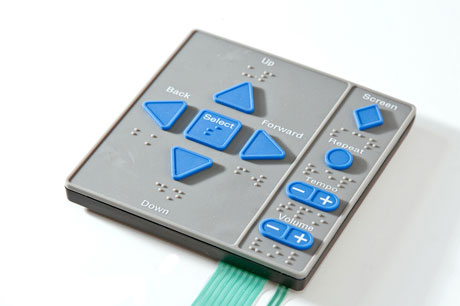Why Membrane Switches are Ideal for Durability and Performance
Recognizing Membrane Switches Over: The Key to Dependable and sturdy Controls

What Are Membrane Switches?
Membrane buttons are a sophisticated service in the world of interface modern technology, combining performance and layout seamlessly. These gadgets work as an interface between individuals and digital systems, incorporating several elements right into a portable layout. Generally built from adaptable, thin layers of materials, membrane switches are developed to reply to touch, allowing customers to communicate with machinery and digital tools properly.
The key elements of a membrane button consist of a printed circuit layer, graphic overlay, and a spacer layer that stops unexpected activation. The graphic overlay can be customized to mirror brand name identification or individual preferences, enhancing aesthetic appeals while making sure functionality. Membrane buttons are generally made use of in different applications, including clinical gadgets, consumer electronics, and commercial devices, owing to their sturdiness and resistance to environmental factors such as dampness and dirt.
One of the vital advantages of membrane layer buttons is their ability to withstand damage, making them suitable for high-traffic environments. In addition, they are light-weight and require marginal area, enabling cutting-edge styles in item advancement. In general, membrane layer changes represent a sensible and effective choice for modern-day electronic user interfaces, marrying technology with user-centric layout principles.
Just How Membrane Layer Switches Job
The operation of membrane layer switches joints on an easy yet efficient device that translates user input into digital signals. When an individual presses the switch, the top layer deforms, allowing a conductive element in the circuit layer to make contact with a corresponding conductive pad on the underside of the visuals overlay.
The layout of membrane layer buttons can differ, but they commonly include domes or tactile elements to offer comments to the customer, boosting the total experience - membrane switch. The products made use of in membrane layer switches, such as polyester or polycarbonate, contribute to their toughness and resistance to ecological variables, consisting of dampness and dirt. The printed circuits are usually encapsulated, which safeguards them from wear and tear over time.
Benefits of Membrane Switches

Additionally, membrane layer buttons are known for their toughness. Created from durable materials, they are resistant to dirt, wetness, and physical wear, which substantially extends their life expectancy contrasted to typical mechanical switches. This toughness makes them particularly suitable for high-traffic atmospheres and applications calling for longevity.
Another considerable advantage is the ease of cleaning and maintenance. The smooth surface of membrane switches over minimizes dirt build-up and is often impervious to spills, making them suitable for settings that require regular sanitization.
Moreover, membrane buttons supply a structured profile, resulting in a thinner design that can be incorporated right into different devices without including mass. This function not only enhances the visual charm but also adds to a much more ergonomic product design.
Applications of Membrane Layer Switches
User-friendly and functional, this hyperlink membrane layer buttons discover applications across a wide variety of industries, consisting of clinical devices, customer electronics, and commercial devices. In the medical area, these switches are indispensable to gadgets such as diagnostic tools, client monitoring systems, and mixture pumps, where dependability and convenience of cleaning are crucial. Their capacity to endure harsh settings and preserve performance makes them perfect for such applications.

In consumer electronic devices, membrane buttons are utilized in items like microwaves, cleaning devices, and remotes - membrane switch. Their sleek style permits intuitive customer interfaces, enhancing the general customer experience while offering resilience and resistance to deterioration
Commercial equipment likewise takes advantage of membrane switches, specifically in control panels for machinery and automation systems. These buttons provide protection against dirt and moisture, making sure regular performance in difficult environments. Their customizable functions allow producers to customize them to specific operational demands, boosting performance and capability.
Picking the Right Membrane Layer Switch Over
When picking a membrane layer button, it is necessary to think about various elements that influence efficiency and viability for details applications. The key factors to consider consist of ecological conditions, tactile comments, longevity, and layout requirements.
First, analyze the operating environment; buttons revealed to dampness, chemicals, or severe temperature levels need details materials to ensure long life and capability. Next off, assess the need for responsive comments. Depending on customer communication, some applications may gain from a responsive reaction to validate activation, while others might like a non-tactile design for visual factors.
Toughness is one more crucial factor; membrane layer switches should be made to hold up against regular usage, effects, and abrasion. Guarantee the selected button can endure the anticipated lifecycle, specifically in high-usage situations.

Final Thought
Finally, membrane switches work as crucial parts in the style of reliable and sturdy control systems across various sectors. Their small design, incorporated with durable construction and personalized functions, enhances customer interaction while ensuring durability in demanding environments. The adaptability of membrane switches over permits customized options that meet specific functional needs, reinforcing their value in contemporary innovation. As industries remain to develop, the relevance of integrating reliable use this link membrane button solutions can not be overstated.
Membrane changes stand for a critical aspect of contemporary user interface layout, mixing capability with resilience in various applications.Membrane switches are an innovative solution in the realm of user interface technology, integrating performance and style effortlessly. Commonly created from adaptable, slim layers of products, description membrane layer buttons are made to react to touch, making it possible for customers to connect with equipment and digital tools properly.
The layout of membrane layer buttons can vary, however they commonly integrate domes or tactile aspects to offer feedback to the user, enhancing the total experience.In verdict, membrane layer changes serve as important components in the design of trusted and sturdy control systems throughout different markets.